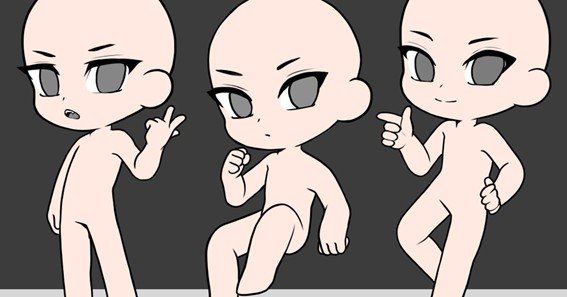Chibi art, characterized by its adorable, exaggerated features and miniature proportions, has become a beloved style among artists and enthusiasts alike. Central to creating chibi characters is the use of “chibi bases,” which serve as foundational templates for artists to build upon.
What Is A Chibi Base?
A chibi base is a simplified outline or template of a chibi character, typically depicting the basic body structure without detailed features. These bases provide a starting point for artists, allowing them to focus on adding unique characteristics, clothing, and expressions without constructing the figure from scratch.
Uses Of Chibi Bases
- Learning Tool: For beginners, chibi bases offer a framework to practice proportions and poses, aiding in skill development.
- Time-Saving: Experienced artists utilize bases to expedite the drawing process, especially when creating multiple characters or commissions.
- Customization: Bases can be adapted and personalized, enabling artists to experiment with different styles and designs efficiently.
Where To Find Chibi Bases
Numerous online platforms provide chibi bases, both free and paid, catering to diverse artistic needs:
- DeviantArt: A vast community where artists share free-to-use (F2U) and pay-to-use (P2U) chibi bases. For instance, Nukababe offers a collection of chibi pose references suitable for various projects.
- Pinterest: Boards like “Chibi Bases” compile extensive collections of bases, providing inspiration and templates for artists.
- Etsy: For those seeking unique or commercial-use bases, Etsy offers a range of chibi base templates created by independent artists.
Creating Your Own Chibi Base
While pre-made bases are helpful, developing your own can enhance your understanding of chibi anatomy and style:
- Start with Basic Shapes: Draw a circle for the head and simple shapes for the body to establish proportions.
- Exaggerate Features: Chibi characters typically have larger heads and smaller bodies; emphasize these traits.
- Simplify Details: Focus on capturing the essence of the character with minimal lines and features.
For a detailed tutorial, KawaiiHannah provides insights into drawing chibi bases, guiding artists through the process.
Tips For Using Chibi Bases
- Respect Usage Rights: Always check the creator’s terms of use; some bases are free for personal use but require permission or payment for commercial projects.
- Credit Original Artists: When using someone else’s base, provide appropriate credit to acknowledge their work.
- Experiment and Modify: Feel free to adjust and customize bases to suit your style and the specific needs of your artwork.
Conclusion
Chibi bases are invaluable tools in the realm of chibi art, offering both novices and seasoned artists a foundation to create charming and expressive characters. By utilizing available resources or crafting your own bases, you can streamline your creative process and bring your unique chibi visions to life.
FAQ
- What are chibi bases used for?
- Chibi bases serve as foundational templates that artists can build upon to create chibi characters, streamlining the drawing process and ensuring consistent proportions.
- Where can I find free chibi bases?
- Platforms like DeviantArt and Pinterest offer a variety of free chibi bases shared by artists. Always check the usage rights before incorporating them into your work.
- Can I use chibi bases for commercial projects?
- It depends on the creator’s terms of use. Some artists allow their bases to be used commercially, often requiring the purchase of a license or proper attribution.
- How can I create my own chibi base?
- Start by sketching basic shapes to establish proportions, exaggerate features typical of chibi characters (like larger heads and smaller bodies), and simplify details to capture the essence of the character.
- Is it necessary to credit the artist when using a chibi base?
- Yes, if you’re using a base created by another artist, it’s important to credit them, especially when sharing your work publicly, to acknowledge their contribution.










